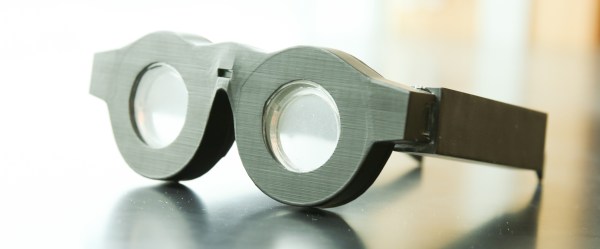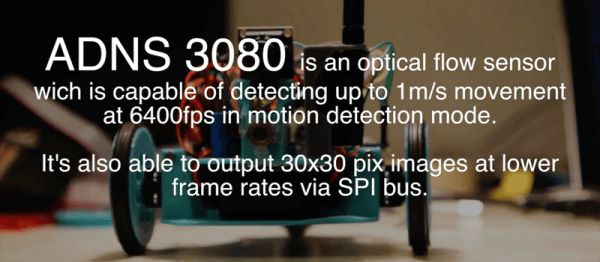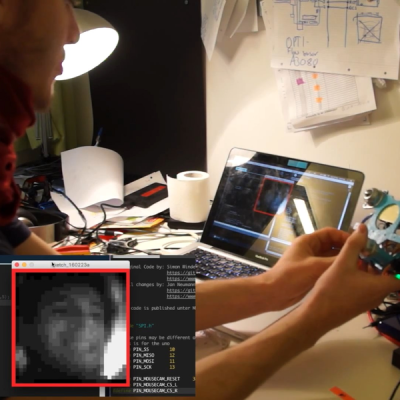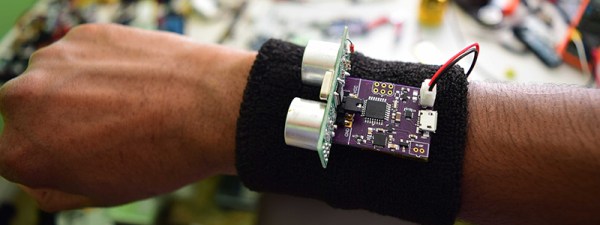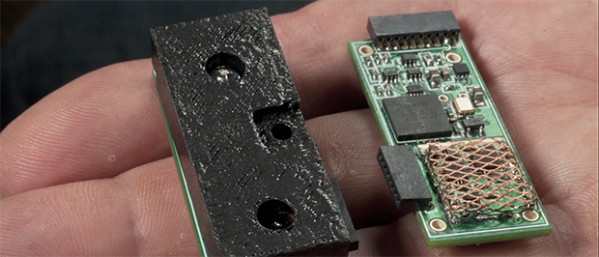I’m working on a project involving the need to precisely move a tool based on the measured distance to an object. Okay, yeah, it’s a CNC mill. Anyway, I’d heard of time of fight sensors and decided to get one to test out, but also to be thorough I wanted to include other distance sensors as well: a Sharp digital distance sensor as well as a more sophisticated proximity/light sensor. I plugged them all into a breadboard and ran them through their paces, using a frame built from aluminum beams as a way of holding the target materials at a specific height.
distance sensor17 Articles
Ultrasonic Raspberry Pi Piano
Cheap stuff gets our creative juices flowing. Case in point? [Andy Grove] built an eight-sensor HC-SR04 breakout board, because the ultrasonic distance sensors in question are so affordable that a hacker can hardly avoid ordering them by the dozen. He originally built it for robotics, but then it’s just a few lines of code to turn it into a gesture-controllable musical instrument. Check out the video, embedded below, for an overview of the features.
His Octasonic breakout board is just an AVR in disguise — it reads from eight ultrasonic sensors and delivers a single SPI result to whatever other controller is serving as the brains. In the “piano” demo, that’s a Raspberry Pi, so he needed the usual 5 V to 3.3 V level shifting in between.
The rest is code on the Pi that enables gestures to play notes, change musical instruments, and even shut the Pi down. The Pi code is written in Rust, and up on GitHub. An Instructable has more detail on the hookups.
All in all, building a “piano” out of robot parts is surely a case of having a hammer and every problem looking like a nail, but we find some of the resulting nail-sculptures arise that way. This isn’t the first time we’ve seen an eight-sensor ultrasonic setup before, either. Is 2017 going to be the year of ultrasonic sensor projects? Continue reading “Ultrasonic Raspberry Pi Piano”
Smart Eyeglasses That Auto Focus Where You Look
A University of Utah team have a working prototype of a new twist on fluid-filled lenses for correction of vision problems: automatic adjustment and refocus depending on what you’re looking at. Technically, the glasses have a distance sensor embedded into the front of the frame and continually adjust the focus of the lenses. An 8 gram, 110 mAh battery powers the prototype for roughly 6 hours.
Eyeglasses that can adapt on the fly to different focal needs is important because many people with degraded vision suffer from more than one condition at the same time, which makes addressing their vision problems more complex than a single corrective lens. For example, many people who are nearsighted or farsighted (where near objects and far objects far objects and near objects are seen out of focus, respectively) also suffer from a general loss of the eye’s ability to change focus, a condition that is age-related. As a result, people require multiple sets of eyeglasses for different conditions. Bifocal or trifocal or progressive lenses are really just multiple sets of lenses squashed into a smaller form factor, and greatly reduce the wearer’s field of view which is itself a significant vision impairment. A full field of view could be restored if eyeglass lenses were able to adapt to different needs based on object distance, and that is what this project achieves.
Continue reading “Smart Eyeglasses That Auto Focus Where You Look”
Mouse Brains Plus Line Laser Equals Rangefinder
[Neumi] wrote in with a sweet robotics hack. It’s a 2D laser distance sensor (YouTube) made with a cheap line laser and an optical mouse’s flow-sensor chip used as a low-resolution camera. In one sense, it’s a standard laser-distance-sensor project. But it is clever for a whole bunch of reasons.
For one, using a mouse sensor as a low-res camera is awesome. It’s designed to read from a standard red LED, so the sensitivity is in just the right ballpark for use with a line laser. It returns a 30×30 pixel greyscale image, which is just about the right amount of data for a low-end microcontroller to handle and keep up with the framerate without resorting to coding tricks.
It’s also no coincidence that these sensors are available with lenses built in, for relatively cheap, on eBay. Apparently the quadcopter gurus use them as if they were mice to visually track their quad’s motion. Hacker spillover!
Detecting the laser line as it reflects off of whatever objects are lying on [Neumi]’s floor could also possibly prove difficult, and might produce false readings in the presence of background illumination. So [Neumi] takes two readings with the camera — one with the laser on and one with it off — and differences them. Done fast enough, this should reduce any non-laser sources down to the sensor’s noise floor. Finally, there’s some thresholding and averaging going on behind the scenes that help make everything work out right. The code is up on GitHub.
Not a bad build for a 2D laser distance system on a budget. If you want to shell out a bit more money, and are into a seriously involved build, this is probably the slickest we’ve seen in a long time. And if you’re thinking that you’ve heard of [Neumi] before, you’re right: we featured this 405mm laser PCB exposer / burner CNC machine just a few months ago.
Continue reading “Mouse Brains Plus Line Laser Equals Rangefinder”
Hackaday Prize Semifinalist: Haptic Navigation
For his project entered in the Hackaday Prize, [Neil] is working on a navigation aid for the blind. He’s calling his device Pathfinder, and it’s designed to allow greater freedom of motion for the disabled.
Pathfinder is a relatively simple device, with a cheap, off the shelf ultrasonic distance sensor, an ATMega, and a few passives. On its own, the ultrasonic distance sensor is only accurate to about 5%. By incorporating a temperature sensor, [Neil] was able to nail down the accuracy of his sensor to about 1%. Impressive!
For the machine to human interface, [Neil] chose haptic feedback, or small vibration motors tucked away inside a wristband. It’s by far the easiest way to add the output needed, and with a haptic motor driver, it’s easy to add specialized drive patterns to the vibration motor
You can check out [Neil]’s quarterfinal entry video for the Pathfinder below.
Continue reading “Hackaday Prize Semifinalist: Haptic Navigation”
New Part Day: Time Of Flight Sensors
Every robotics project out there, it seems, needs a way to detect if it’s smashing into a wall repeatedly, acting like the brainless automaton it actually is. The Roomba has wall sensors, just about every robot kit has some way of detecting obstacles its running into, and for ‘wall-following robots’, detecting objects is all they do.
While the earliest of these robots used a piece of wire and a metal contact to act like a switch for these object detectors, ultrasonic sensors – the kind you can buy on eBay for a few bucks – have replaced this clever wire spring switch. Now there’s a new sensor for the same job – the VL6180 – and it measures the speed of light.
The sensors that are used for object and collision detection now use either ultrasonic or infrared light. They’re susceptible to noise, and if you’re doing anything automated, you really don’t want rogue measurements. A time of flight sensor clocks out photons and records how long it takes them to return at 299,792,458 meters per second. It’s less sensitive to noise, and if you can believe this SparkFun demo of this sensor, extremely accurate
This is not the first Time of Flight distance sensor on the market; earlier this week we saw a project use a sensor called the TeraRanger One. This sensor costs €150.00. The VL6180 sensor costs about $6 in quantity one from the usual suspects, and breakout boards with the proper level converters and regulators can be found for about $25. More expensive sensors have a greater range, naturally; the VL6180 is limited to somewhere between 10cm (on paper) and 25cm (in practice). But this is cheap, and it measures the time of flight of pulses of light. That’s just cool.
LIDAR With LEDs For Under $100
If you need some sort of distance sensor for your robot, drone, or other project, you have two options: a cheap ultrasonic sensor with limited range, or an expensive laser-based system that’s top of the line. LIDAR-Lite fills that gap by stuffing an entire LIDAR module onto a small board.
In traditional LIDAR systems, a laser is used to measure the time of flight for a light beam between the sensor and an object. The very accurate clock and laser module required for this system means LIDAR modules cost at least a few hundred dollars. LIDAR-Lite gets around these problems by blinking a LED with a ‘signature’ and looking for that signature’s return. This tech is packaged inside a SoC that reduces both the cost and size of a traditional laser-based LIDAR system.
As for the LIDAR-Lite specs, it can sense objects out to 40 meters with 5% 95% accuracy, communicates to any microcontroller over an I2C bus, and is small enough to fit inside any project.
Considering the existing solutions for distance measurement for robots and quadcopters, this sensor will certainly make for some very awesome projects.
Edit: One of the guys behind this posted a link to their spec sheet and a patent in the comments



